Hyundai Terracan 2004 Owner's Manual
Manufacturer: HYUNDAI, Model Year: 2004, Model line: Terracan, Model: Hyundai Terracan 2004Pages: 361, PDF Size: 4.69 MB
Page 311 of 361
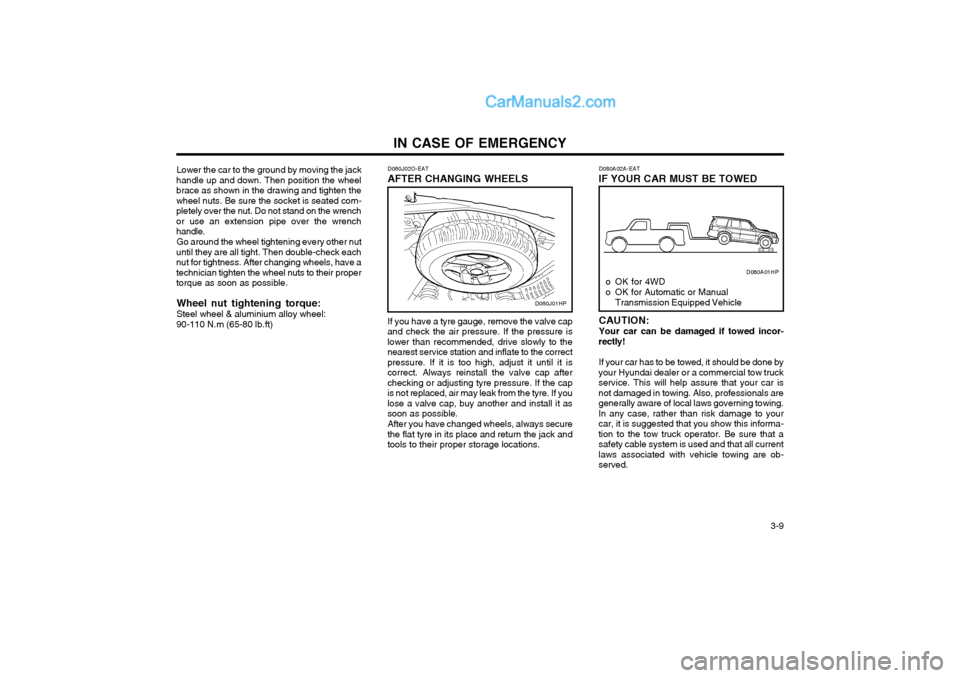
IN CASE OF EMERGENCY 3-9
D060J01HP
Lower the car to the ground by moving the jack
handle up and down. Then position the wheel brace as shown in the drawing and tighten thewheel nuts. Be sure the socket is seated com-pletely over the nut. Do not stand on the wrenchor use an extension pipe over the wrenchhandle.
Go around the wheel tightening every other nut
until they are all tight. Then double-check eachnut for tightness. After changing wheels, have atechnician tighten the wheel nuts to their propertorque as soon as possible.
Wheel nut tightening torque: Steel wheel & aluminium alloy wheel:90-110 N.m (65-80 lb.ft) D060J02O-EAT
AFTER CHANGING WHEELS
If you have a tyre gauge, remove the valve cap
and check the air pressure. If the pressure is lower than recommended, drive slowly to thenearest service station and inflate to the correctpressure. If it is too high, adjust it until it iscorrect. Always reinstall the valve cap afterchecking or adjusting tyre pressure. If the capis not replaced, air may leak from the tyre. If youlose a valve cap, buy another and install it assoon as possible.
After you have changed wheels, always secure
the flat tyre in its place and return the jack andtools to their proper storage locations. D080A02A-EAT
IF YOUR CAR MUST BE TOWED
o OK for 4WD
o OK for Automatic or Manual Transmission Equipped Vehicle D080A01HP
CAUTION:Your car can be damaged if towed incor-
rectly!
If your car has to be towed, it should be done by
your Hyundai dealer or a commercial tow truck service. This will help assure that your car isnot damaged in towing. Also, professionals aregenerally aware of local laws governing towing.In any case, rather than risk damage to yourcar, it is suggested that you show this informa-tion to the tow truck operator. Be sure that asafety cable system is used and that all currentlaws associated with vehicle towing are ob-served.
Page 312 of 361
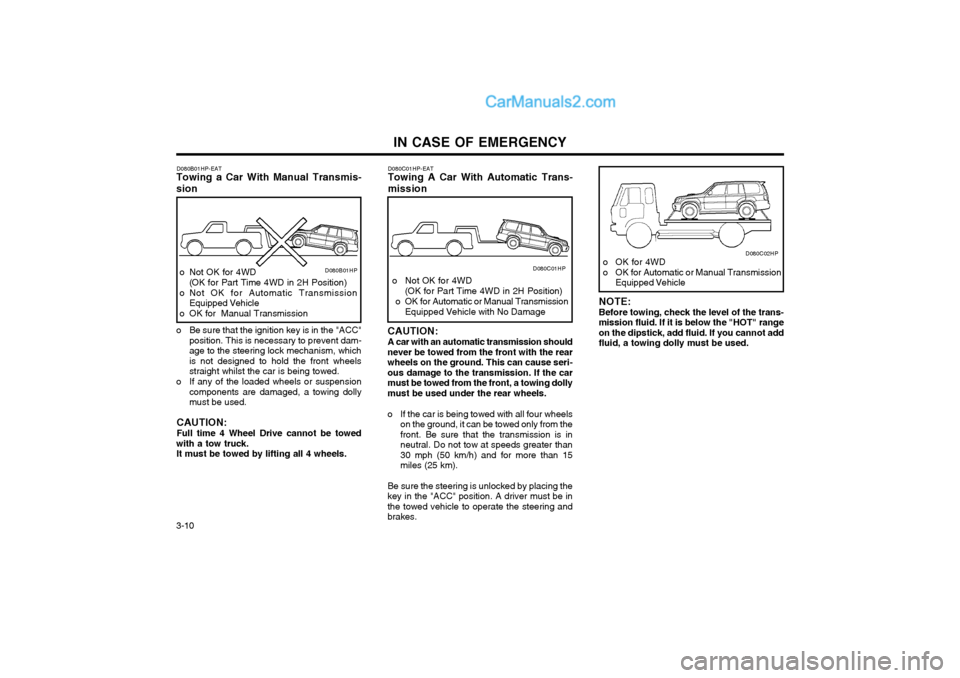
IN CASE OF EMERGENCY
3-10 D080B01HP-EAT
Towing a Car With Manual Transmis- sion
o Not OK for 4WD
(OK for Part Time 4WD in 2H Position)
o Not OK for Automatic Transmission Equipped Vehicle
o OK for Manual Transmission D080B01HP
o Be sure that the ignition key is in the "ACC" position. This is necessary to prevent dam- age to the steering lock mechanism, whichis not designed to hold the front wheelsstraight whilst the car is being towed.
o If any of the loaded wheels or suspension components are damaged, a towing dollymust be used.
CAUTION: Full time 4 Wheel Drive cannot be towed
with a tow truck. It must be towed by lifting all 4 wheels.o OK for 4WD
o OK for Automatic or Manual Transmission Equipped VehicleD080C02HP
NOTE: Before towing, check the level of the trans- mission fluid. If it is below the "HOT" rangeon the dipstick, add fluid. If you cannot addfluid, a towing dolly must be used.
D080C01HP-EAT
Towing A Car With Automatic Trans- mission
CAUTION: A car with an automatic transmission should never be towed from the front with the rearwheels on the ground. This can cause seri-ous damage to the transmission. If the carmust be towed from the front, a towing dollymust be used under the rear wheels.
o If the car is being towed with all four wheels on the ground, it can be towed only from thefront. Be sure that the transmission is inneutral. Do not tow at speeds greater than30 mph (50 km/h) and for more than 15miles (25 km).
Be sure the steering is unlocked by placing thekey in the "ACC" position. A driver must be inthe towed vehicle to operate the steering andbrakes.
o Not OK for 4WD (OK for Part Time 4WD in 2H Position)
o OK for Automatic or Manual Transmission Equipped Vehicle with No Damage
D080C01HP
Page 313 of 361
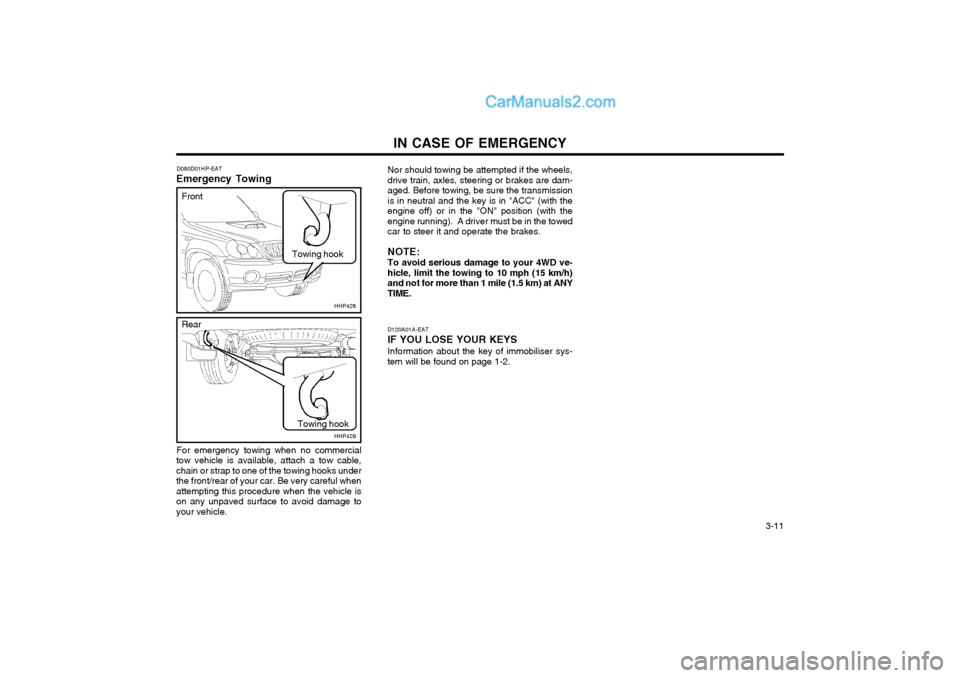
IN CASE OF EMERGENCY 3-11
D120A01A-EAT
IF YOU LOSE YOUR KEYS Information about the key of immobiliser sys-
tem will be found on page 1-2.
D080D01HP-EAT
Emergency Towing Nor should towing be attempted if the wheels, drive train, axles, steering or brakes are dam-aged. Before towing, be sure the transmissionis in neutral and the key is in "ACC" (with theengine off) or in the "ON" position (with theengine running). A driver must be in the towedcar to steer it and operate the brakes. NOTE: To avoid serious damage to your 4WD ve- hicle, limit the towing to 10 mph (15 km/h)and not for more than 1 mile (1.5 km) at ANYTIME.
HHP428
Front Rear
HHP429
Towing hook
Towing hook
For emergency towing when no commercial
tow vehicle is available, attach a tow cable, chain or strap to one of the towing hooks underthe front/rear of your car. Be very careful whenattempting this procedure when the vehicle ison any unpaved surface to avoid damage toyour vehicle.
Page 314 of 361
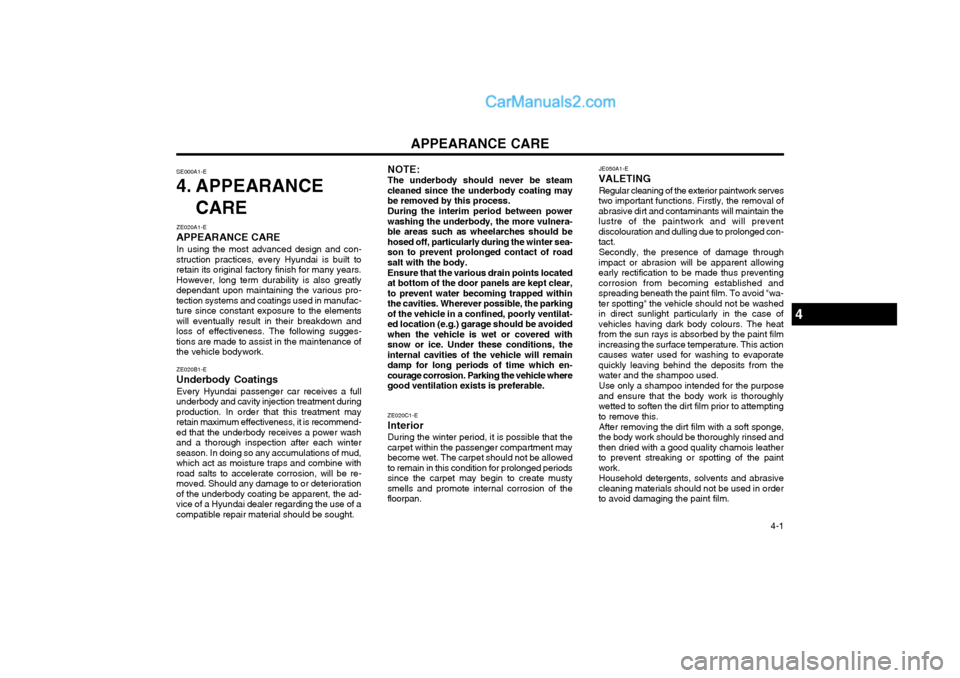
APPEARANCE CARE 4-1
NOTE: The underbody should never be steam
cleaned since the underbody coating may be removed by this process.
During the interim period between power
washing the underbody, the more vulnera-ble areas such as wheelarches should behosed off, particularly during the winter sea-son to prevent prolonged contact of roadsalt with the body.
Ensure that the various drain points located
at bottom of the door panels are kept clear,to prevent water becoming trapped withinthe cavities. Wherever possible, the parkingof the vehicle in a confined, poorly ventilat-ed location (e.g.) garage should be avoidedwhen the vehicle is wet or covered withsnow or ice. Under these conditions, theinternal cavities of the vehicle will remaindamp for long periods of time which en-courage corrosion. Parking the vehicle wheregood ventilation exists is preferable. JE050A1-E
VALETING
Regular cleaning of the exterior paintwork serves
two important functions. Firstly, the removal ofabrasive dirt and contaminants will maintain thelustre of the paintwork and will preventdiscolouration and dulling due to prolonged con-tact.
Secondly, the presence of damage through
impact or abrasion will be apparent allowingearly rectification to be made thus preventingcorrosion from becoming established andspreading beneath the paint film. To avoid "wa-ter spotting" the vehicle should not be washedin direct sunlight particularly in the case ofvehicles having dark body colours. The heatfrom the sun rays is absorbed by the paint filmincreasing the surface temperature. This actioncauses water used for washing to evaporatequickly leaving behind the deposits from thewater and the shampoo used.
Use only a shampoo intended for the purpose
and ensure that the body work is thoroughlywetted to soften the dirt film prior to attemptingto remove this.
After removing the dirt film with a soft sponge,
the body work should be thoroughly rinsed andthen dried with a good quality chamois leatherto prevent streaking or spotting of the paintwork. Household detergents, solvents and abrasive
cleaning materials should not be used in orderto avoid damaging the paint film.
SE000A1-E
4. APPEARANCE
CARE
ZE020A1-E
APPEARANCE CARE
In using the most advanced design and con-
struction practices, every Hyundai is built to retain its original factory finish for many years.However, long term durability is also greatlydependant upon maintaining the various pro-tection systems and coatings used in manufac-ture since constant exposure to the elementswill eventually result in their breakdown andloss of effectiveness. The following sugges-tions are made to assist in the maintenance ofthe vehicle bodywork.
ZE020B1-E
Underbody Coatings Every Hyundai passenger car receives a full
underbody and cavity injection treatment duringproduction. In order that this treatment mayretain maximum effectiveness, it is recommend-ed that the underbody receives a power washand a thorough inspection after each winterseason. In doing so any accumulations of mud,which act as moisture traps and combine withroad salts to accelerate corrosion, will be re-moved. Should any damage to or deteriorationof the underbody coating be apparent, the ad-vice of a Hyundai dealer regarding the use of acompatible repair material should be sought. ZE020C1-E
Interior During the winter period, it is possible that the
carpet within the passenger compartment maybecome wet. The carpet should not be allowedto remain in this condition for prolonged periodssince the carpet may begin to create mustysmells and promote internal corrosion of thefloorpan.
4
Page 315 of 361
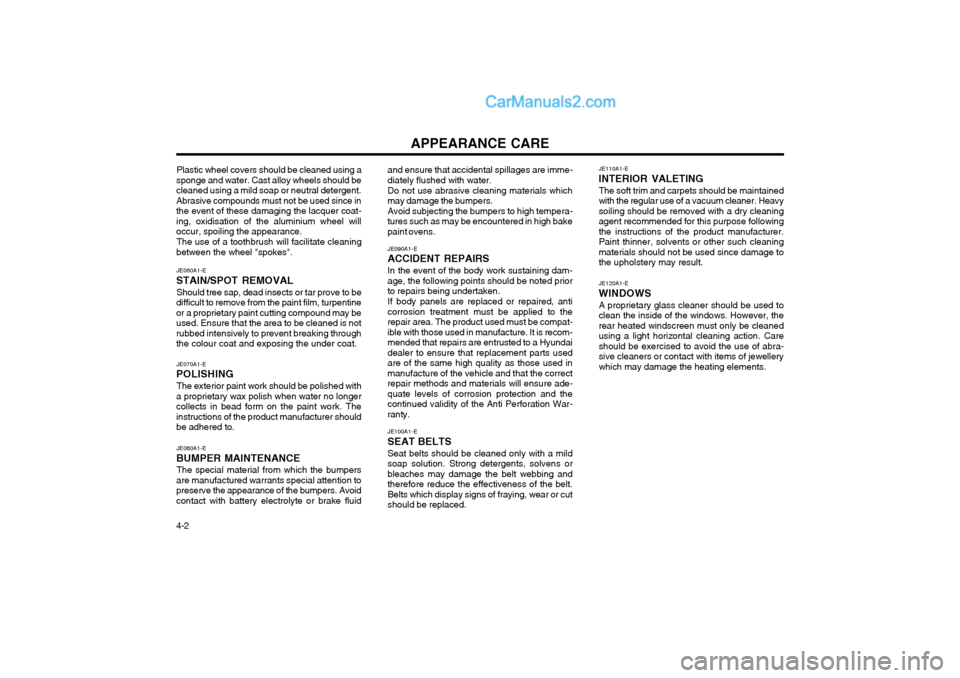
APPEARANCE CARE
4-2 JE070A1-E
POLISHING
The exterior paint work should be polished with
a proprietary wax polish when water no longer collects in bead form on the paint work. Theinstructions of the product manufacturer shouldbe adhered to. JE120A1-E
WINDOWS A proprietary glass cleaner should be used toclean the inside of the windows. However, therear heated windscreen must only be cleanedusing a light horizontal cleaning action. Careshould be exercised to avoid the use of abra-sive cleaners or contact with items of jewellerywhich may damage the heating elements.
Plastic wheel covers should be cleaned using a
sponge and water. Cast alloy wheels should becleaned using a mild soap or neutral detergent.Abrasive compounds must not be used since inthe event of these damaging the lacquer coat-ing, oxidisation of the aluminium wheel willoccur, spoiling the appearance.
The use of a toothbrush will facilitate cleaning
between the wheel "spokes". and ensure that accidental spillages are imme-diately flushed with water.
Do not use abrasive cleaning materials whichmay damage the bumpers.Avoid subjecting the bumpers to high tempera-tures such as may be encountered in high bakepaint ovens. JE110A1-E
INTERIOR VALETING
The soft trim and carpets should be maintainedwith the regular use of a vacuum cleaner. Heavysoiling should be removed with a dry cleaningagent recommended for this purpose followingthe instructions of the product manufacturer.Paint thinner, solvents or other such cleaningmaterials should not be used since damage tothe upholstery may result.
JE060A1-E
STAIN/SPOT REMOVAL Should tree sap, dead insects or tar prove to be
difficult to remove from the paint film, turpentineor a proprietary paint cutting compound may beused. Ensure that the area to be cleaned is notrubbed intensively to prevent breaking throughthe colour coat and exposing the under coat.
JE080A1-E
BUMPER MAINTENANCE The special material from which the bumpers
are manufactured warrants special attention topreserve the appearance of the bumpers. Avoidcontact with battery electrolyte or brake fluid JE090A1-E
ACCIDENT REPAIRS
In the event of the body work sustaining dam-age, the following points should be noted priorto repairs being undertaken. If body panels are replaced or repaired, anti corrosion treatment must be applied to therepair area. The product used must be compat-ible with those used in manufacture. It is recom-mended that repairs are entrusted to a Hyundaidealer to ensure that replacement parts usedare of the same high quality as those used inmanufacture of the vehicle and that the correctrepair methods and materials will ensure ade-quate levels of corrosion protection and thecontinued validity of the Anti Perforation War-ranty. JE100A1-E
SEAT BELTS
Seat belts should be cleaned only with a mild soap solution. Strong detergents, solvens orbleaches may damage the belt webbing andtherefore reduce the effectiveness of the belt.Belts which display signs of fraying, wear or cutshould be replaced.
Page 316 of 361
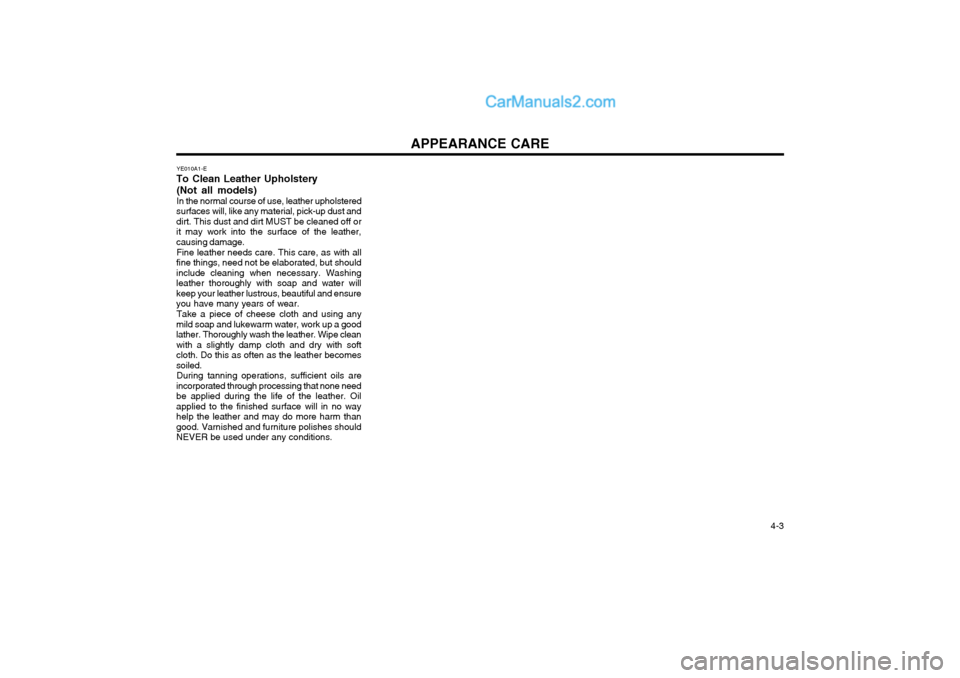
APPEARANCE CARE 4-3
YE010A1-E
To Clean Leather Upholstery
(Not all models) In the normal course of use, leather upholstered
surfaces will, like any material, pick-up dust and dirt. This dust and dirt MUST be cleaned off orit may work into the surface of the leather,causing damage.
Fine leather needs care. This care, as with all
fine things, need not be elaborated, but shouldinclude cleaning when necessary. Washingleather thoroughly with soap and water willkeep your leather lustrous, beautiful and ensureyou have many years of wear.
Take a piece of cheese cloth and using any
mild soap and lukewarm water, work up a goodlather. Thoroughly wash the leather. Wipe cleanwith a slightly damp cloth and dry with softcloth. Do this as often as the leather becomessoiled. During tanning operations, sufficient oils are
incorporated through processing that none needbe applied during the life of the leather. Oilapplied to the finished surface will in no wayhelp the leather and may do more harm thangood. Varnished and furniture polishes shouldNEVER be used under any conditions.
Page 317 of 361
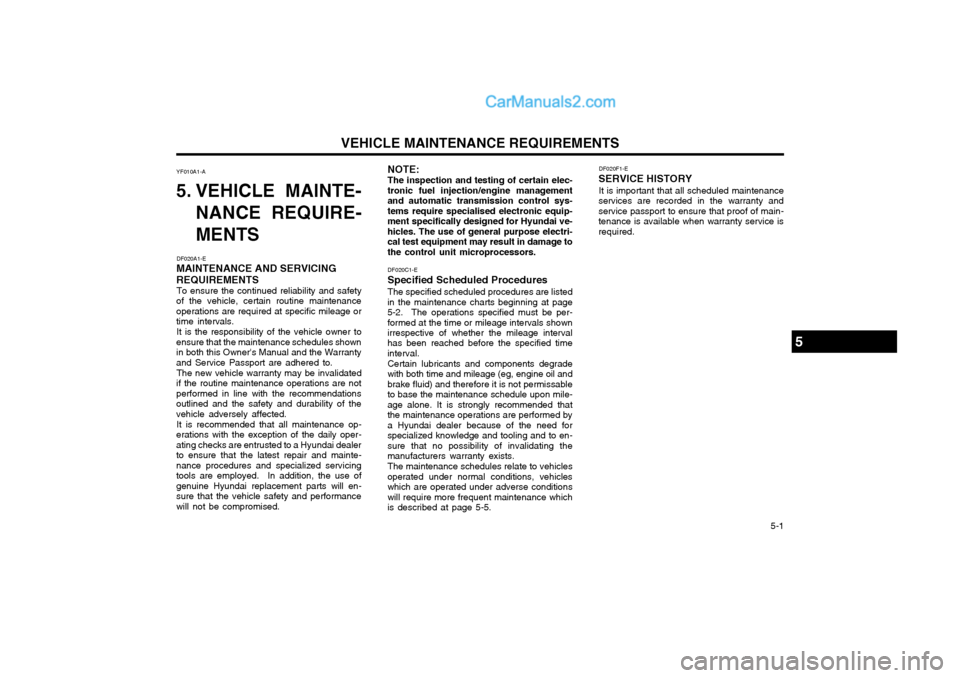
VEHICLE MAINTENANCE REQUIREMENTS 5-1
NOTE:
The inspection and testing of certain elec-
tronic fuel injection/engine management and automatic transmission control sys-tems require specialised electronic equip-ment specifically designed for Hyundai ve-hicles. The use of general purpose electri-cal test equipment may result in damage tothe control unit microprocessors.
YF010A1-A
5. VEHICLE MAINTE-
NANCE REQUIRE- MENTS
DF020A1-E
MAINTENANCE AND SERVICING REQUIREMENTS To ensure the continued reliability and safety
of the vehicle, certain routine maintenance operations are required at specific mileage ortime intervals.
It is the responsibility of the vehicle owner to
ensure that the maintenance schedules shownin both this Owner's Manual and the Warrantyand Service Passport are adhered to.
The new vehicle warranty may be invalidated
if the routine maintenance operations are notperformed in line with the recommendationsoutlined and the safety and durability of thevehicle adversely affected.
It is recommended that all maintenance op-
erations with the exception of the daily oper-ating checks are entrusted to a Hyundai dealerto ensure that the latest repair and mainte-nance procedures and specialized servicingtools are employed. In addition, the use ofgenuine Hyundai replacement parts will en-sure that the vehicle safety and performancewill not be compromised. DF020C1-E
Specified Scheduled Procedures The specified scheduled procedures are listed
in the maintenance charts beginning at page5-2. The operations specified must be per-formed at the time or mileage intervals shownirrespective of whether the mileage interval has been reached before the specified time interval.
Certain lubricants and components degrade
with both time and mileage (eg, engine oil andbrake fluid) and therefore it is not permissableto base the maintenance schedule upon mile-age alone. It is strongly recommended thatthe maintenance operations are performed bya Hyundai dealer because of the need forspecialized knowledge and tooling and to en-sure that no possibility of invalidating themanufacturers warranty exists.
The maintenance schedules relate to vehicles
operated under normal conditions, vehicleswhich are operated under adverse conditionswill require more frequent maintenance whichis described at page 5-5. DF020F1-E
SERVICE HISTORY
It is important that all scheduled maintenance
services are recorded in the warranty andservice passport to ensure that proof of main-tenance is available when warranty service isrequired.
5
Page 318 of 361
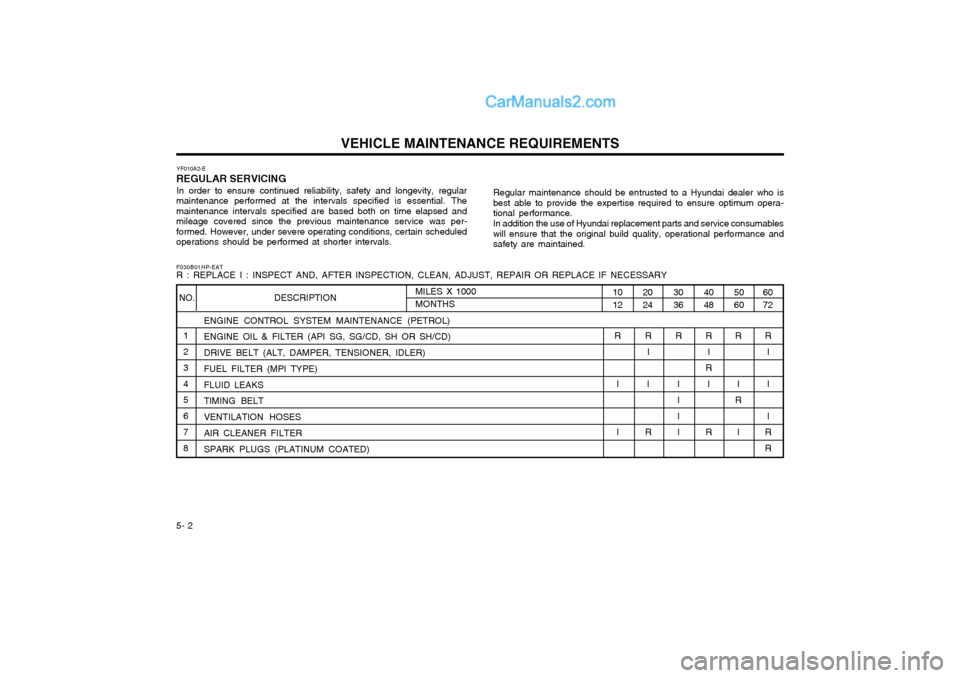
VEHICLE MAINTENANCE REQUIREMENTS
5- 2 YF010A2-E
REGULAR SERVICING
In order to ensure continued reliability, safety and longevity, regular
maintenance performed at the intervals specified is essential. The maintenance intervals specified are based both on time elapsed andmileage covered since the previous maintenance service was per-formed. However, under severe operating conditions, certain scheduledoperations should be performed at shorter intervals. Regular maintenance should be entrusted to a Hyundai dealer who is
best able to provide the expertise required to ensure optimum opera-tional performance.
In addition the use of Hyundai replacement parts and service consumables
will ensure that the original build quality, operational performance andsafety are maintained.
F030B01HP-EAT R : REPLACE I : INSPECT AND, AFTER INSPECTION, CLEAN, ADJUST, REPAIR OR REPLACE IF NECESSARY
ENGINE CONTROL SYSTEM MAINTENANCE (PETROL) ENGINE OIL & FILTER (API SG, SG/CD, SH OR SH/CD) DRIVE BELT (ALT, DAMPER, TENSIONER, IDLER) FUEL FILTER (MPI TYPE) FLUID LEAKS TIMING BELT VENTILATION HOSES AIR CLEANER FILTER SPARK PLUGS (PLATINUM COATED)
NO. DESCRIPTION60 72
5060
4048
3036
2024
1012
MILES X 1000 MONTHS
R
I I
l
R R
R
I
R
I
R
l
R
I
R
R
I I I I
R
l
I
R
R
I I1 2 3 4 5 6 7 8
Page 319 of 361
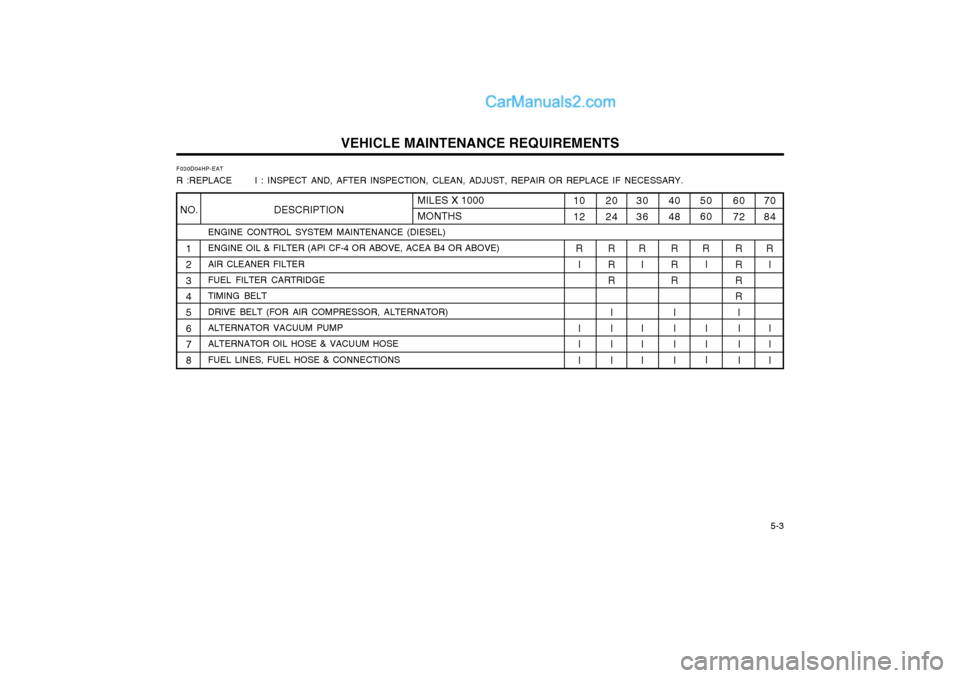
VEHICLE MAINTENANCE REQUIREMENTS 5-3
F030D04HP-EAT R :REPLACE I : INSPECT AND, AFTER INSPECTION, CLEAN, ADJUST, REPAIR OR REPLACE IF NECESSARY.
ENGINE CONTROL SYSTEM MAINTENANCE (DIESEL) ENGINE OIL & FILTER (API CF-4 OR ABOVE, ACEA B4 OR ABOVE) AIR CLEANER FILTERFUEL FILTER CARTRIDGE TIMING BELT DRIVE BELT (FOR AIR COMPRESSOR, ALTERNATOR)ALTERNATOR VACUUM PUMP ALTERNATOR OIL HOSE & VACUUM HOSE FUEL LINES, FUEL HOSE & CONNECTIONS
1 23 4 56 7 8
6072
RRR R l I I I
50 60
R I I I I40 48
RRR II I I20 24RRR II I IMILES X 1000 MONTHS70 84R I I I INO. DESCRIPTION 10 12
R I I I I 3036
R I I I I
Page 320 of 361
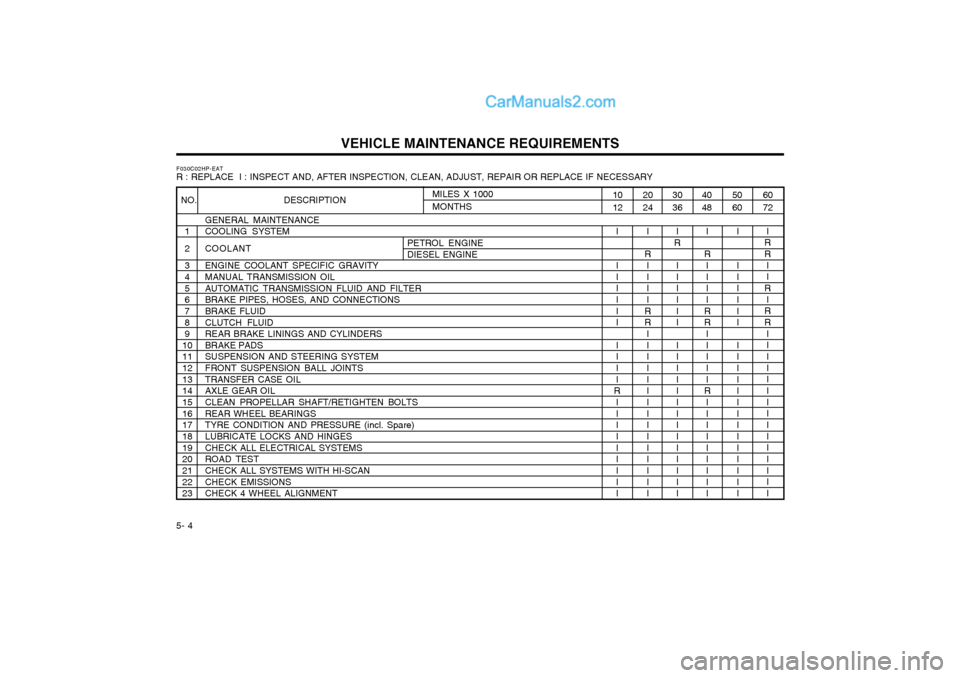
VEHICLE MAINTENANCE REQUIREMENTS
5- 4
F030C02HP-EAT R : REPLACE I : INSPECT AND, AFTER INSPECTION, CLEAN, ADJUST, REPAIR OR REPLACE IF NECESSARY
GENERAL MAINTENANCE COOLING SYSTEM COOLANTENGINE COOLANT SPECIFIC GRAVITY MANUAL TRANSMISSION OIL AUTOMATIC TRANSMISSION FLUID AND FILTER BRAKE PIPES, HOSES, AND CONNECTIONSBRAKE FLUID CLUTCH FLUID REAR BRAKE LININGS AND CYLINDERSBRAKE PADSSUSPENSION AND STEERING SYSTEM FRONT SUSPENSION BALL JOINTS TRANSFER CASE OILAXLE GEAR OIL CLEAN PROPELLAR SHAFT/RETIGHTEN BOLTS REAR WHEEL BEARINGSTYRE CONDITION AND PRESSURE (incl. Spare) LUBRICATE LOCKS AND HINGES CHECK ALL ELECTRICAL SYSTEMSROAD TEST CHECK ALL SYSTEMS WITH HI-SCAN CHECK EMISSIONSCHECK 4 WHEEL ALIGNMENT
60 72
50 60
4048
I
R R
II
R
I
RR
III I II I II I II I II
I I I II I I I II I II I II I II I I
I
R I I II
RR I I II I
R II II I II I I
30 36
2024
I
R
I I II I I I II I II I II I II I I
I
R I I II
RR I I II I II I II I II I I
10 12
I I I II I I I II I
R
II II I II I I
MILES X 1000 MONTHS
NO. DESCRIPTION
1 23 4 5 67 8 9
1011 12 1314 15 1617 18 1920 21
22 23
PETROL ENGINE DIESEL ENGINE